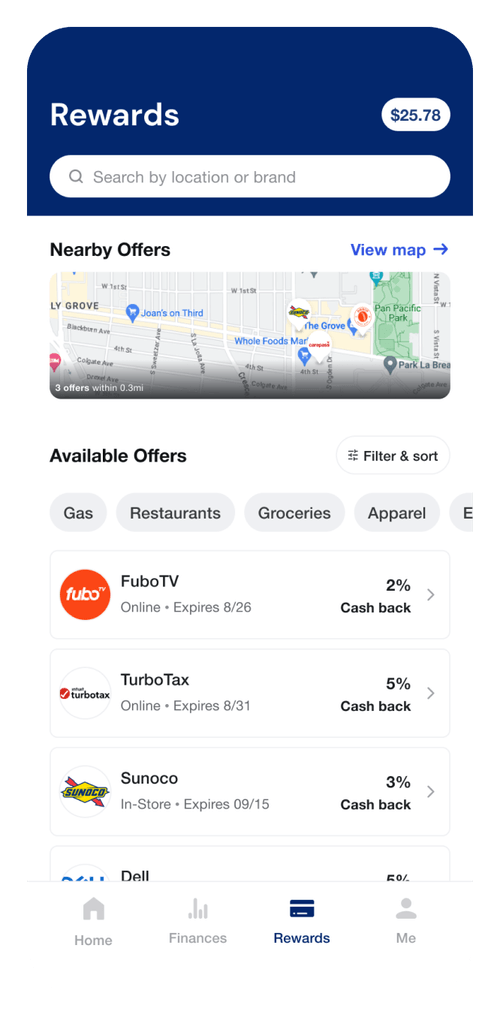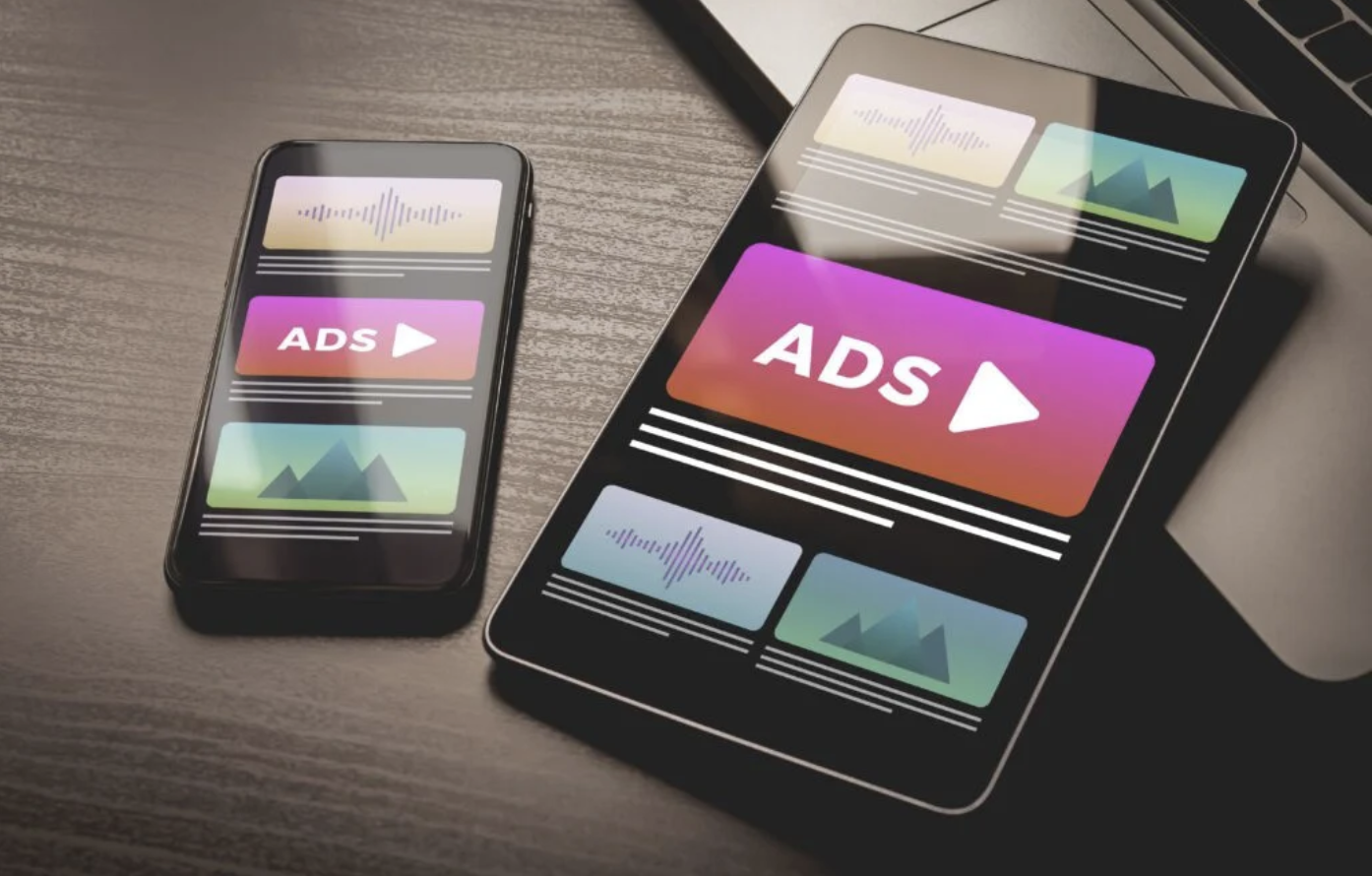With rising CACs and broken attribution models, successful marketers are shifting their focus from social media to new ad formats, that target mobile users in an environment that they already trust.
This article outlines exactly how in-app advertising – one of these new formats – offers better targeting, real engagement, and measurable revenue uplift, while eliminating the risk of fraud and the inefficiency that comes from social spending.
Here’s how to make in-app ads your most successful channel yet.
What Is In-App Advertising? Key Concepts Explained
In-app advertising is pretty much what it sounds like: targeted ads displayed directly within mobile applications. These provide a way for:
- Advertisers to connect with engaged users
- App developers and publishers to generate more revenue
- Users to access great apps without paying a subscription while receiving relevant offers
An in-app ad could take many forms- a video, banner ad or a reward for customers who carry out certain actions like spending a given amount or buying a specified product. With this last example, solutions like Kard offer marketers a handy way to both gather data and close the loop.
Why In-App Advertising Matters for Monetizing Mobile Experiences
In-app advertising offers direct access to users who are already highly engaged and who spend an amazing amount of time using various apps on their mobile devices. This active screen time means mobile apps offer stronger opportunities for monetization than traditional banner ads on websites.
Advertising within apps rather than mobile web placements comes with significant upsides: much better CTRs and improved conversions. These results translate directly into increased revenue, better customer retention, and repeat visits.
Rewards platforms like Kard, for example, allow brands to serve up cash back offers in users’ banking apps, trusted environments users interact with on a regular basis. Even if users don’t redeem those offers right away, brands are still getting seen – and they don’t have to pay for those impressions.
Core Components of Effective In-App Advertising Campaigns
The most effective in-app advertising campaigns tend to use at least one of three core components: native ad integration, immersive displays, and reward-based models. Implementing these three elements ensures that your campaigns resonate with users, driving the engagement that your campaign needs for success.
1. Native Ad Integration
Native ad integration means positioning advertisements as an organic part of the app experience, blending seamlessly into the existing interface. Done well, users see native ads as relevant content rather than interruptions, boosting acceptance and engagement rates. Done badly, they’re jarring. Finance apps, in particular, can benefit from native integration as it helps to preserve the trusted environment that users need for financial interactions.

By blending into trusted environments, audiences see natively integrated advertisements as useful features rather than annoying distractions.
2. Immersive Ad Displays
Immersive ad displays, such as rich-media and interactive banners, encourage active participation rather than active ad viewing from users. Playable ads feature elements like swiping, tapping, or interactive quizzes to capture attention and extend interaction time, improving CTRs and conversions. For example, Temu’s recent gamified campaigns encourage viewers to ‘play’ to win discounts and special offers.
Interactive ad experiences also provide deeper analytics by allowing marketers to track exactly which elements of the advertisement engage users, helping them to refine targeting and optimize future campaigns.
Gamifying the ad experience, whether that’s through interactive ads or tiered rewards like those powered by Kard, means that, rather than being viewed as an annoying distraction from the reason an audience member opened the app, they enhance the experience.
3. Reward-Based Ads
Reward-based models offer users a tangible incentive, such as cash back or loyalty points, in exchange for buying with a particular brand. A popular footwear company offered 5% cashback on new purchases, and grew their market share by 35% in 3 months.
Industry-Specific Use Cases for In-App Advertising
In-app advertising isn't one-size-fits-all. To maximize performance, brands need to align their ad formats and targeting strategies to their ideal customers’ behavior and expectations.
Mobile gaming platforms offer players virtual goods or currency to drive longer sessions and daily use, increasing the number of adverts they are served without disrupting their play. Interstitial ads inserted at natural pauses, like after completing a level or when a player has run out of a resource, offer visibility without disrupting gameplay. Native ads seamlessly blend into games, elevating user experience and boosting click-through without sacrificing player retention. For example, in the game Warhammer 40,000 Tacticus, players can restore a certain amount of energy each day, refresh the in-game currency stores, and gain other small advantages by agreeing to watch ads.
Retailers, on the other hand, can capitalize on personalized content delivery by tapping into first-party purchase and browsing data. Retailers segment users based on past purchases, cart activity, and product preferences, delivering targeted promotions precisely when users display intent. For instance, a shopper who frequently browses athletic gear might receive in-app offers for relevant apparel or accessories, driving repeat purchases and maximizing conversion rates.
How a major clothing retailer drove 167% WoW revenue in 3 months.
Quick-Service Restaurants (QSRs) can use targeted promotions to push store visits and order frequency amongst their customers. By analyzing first-party transaction data, QSR apps can identify user purchase patterns, such as morning coffee runs or weekend takeout orders, and deliver strategically timed incentives like extra menu items. Targeted offers not only increase immediate redemption rates, they also cultivate long-term loyalty, boosting customer lifetime value.
Fintech apps and digital banks integrate personalized rewards directly within trusted financial environments. Using transaction-level insights, fintech providers display merchant-funded rewards that align precisely with user spending habits, like offerings such as cashback or points for shopping at preferred brands. This precise targeting delivers measurable return on ad spend and raises user retention by enhancing the perceived value of the app. Kard provides an easy access path to these high-trust environments.
Selecting Platforms and Tools to Manage In-App Advertising
The key to running scalable, successful in-app advertising campaigns is selecting the right tools. For example, partnering with Kard allows your rewards to be displayed directly in trusted financial apps like digital banks where first-party data can be used to refine your cash back offers and discover new partners based on where else your customers spend.
The Challenges of Implementing In-App Advertising and How to Solve Them
In-app advertising offers a measurable return on investment, but many apps face challenges around data privacy, ad fraud, and regulatory compliance. Without addressing these serious risks, campaigns risk wasting budgets, losing the valuable user trust on which these apps rely, or even opening the door to legal problems around the misuse of data.
Data privacy is a critical concern for both advertisers and consumers, amplified by regulations like GDPR and CCPA. Finance apps that manage sensitive data in particular must be alive to these issues and implement transparent, active consent mechanisms that clearly outline how user data is collected and utilized. Implementing consent management platforms (CMPs) that document and manage user permissions not only ensures legal compliance but also helps to build lasting user trust, as users feel that they have been consulted before their data is used. Regulations like the EU’s GDPR make these considerations even more important and require regular audits to ensure you comply. On the other hand, meeting these requirements comes with a boost in user trust.
Ad fraud poses another significant challenge. Fraudulent clicks, fake installs, and bot-driven impressions erode campaign effectiveness and can mean campaigns cost money without offering results. Combating this means using sophisticated fraud-detection tools to catch anomalies and using machine learning models to identify and block fraudulent traffic before it can impact ad spend and render your metrics all but meaningless. Of course, if your ads are displayed in environments like banking apps through partnering with Kard, that bank’s top-level security serves as a powerful barrier to this problem.
Learn how Kard ensures zero ad fraud and helps brands drive real results.
Having ads displayed in the right places can pose a serious challenge for in-app marketers. Partnering with rewards-based ad platforms like Kard means that your offers will be shown in high-trust environments like banking apps, preserving your reputation.
Naturally, these issues are either eliminated or vastly reduced when the app in question is something like a bank’s digital portal. Fraudulent clicks are all but illuminated through biometric logins, data privacy is covered by the strict regulations around the financial industry, and placement is automatically in a high-trust environment. Partnering with Kard makes this possible.
Addressing these complexities upfront protects budgets and maintains the trusted, high-engagement environments essential for profitable rewards-based campaigns.
Expert Tips and Best Practices for Optimizing In-App Advertising Performance
To get the most out of your mobile app ads, you have to strike a balance between being noticeable and being intrusive. And that requires some testing.
A/B testing can help pinpoint exactly which ad placements, formats, and creative elements drive the strongest user responses, allowing you to focus on what works and constantly develop more effective strategies. By running controlled experiments within your app, like showing two versions of the same video before dropping the least successful, you can quickly identify high-performing variants, ensuring ad spend goes only to proven winners.
Getting placement strategies right can amplify the effectiveness of your in-app advertising, too. Heatmaps and detailed analytics can reveal precise user interactions and attention patterns within your app, helping you reposition ads strategically, boosting visibility without disrupting the user experience.
Creative design significantly influences campaign outcomes as well, both in terms of how the campaign and each individual advert are structured.
Follow these proven guidelines for ads that convert:
- Deliver concise messaging to quickly communicate value.
- Prioritize clear and prominent CTAs to drive immediate user action.
- Optimize visuals for clarity and quick loading times.
- Minimize disruption by aligning ad aesthetics with the app’s native content.
Performance Measurement and Attribution for In-App Advertising
Measuring how effective your in-app advertising is means looking carefully at performance and revenue impact:
- Modeling performance attribution gives a precise measurement of how a specific ad and placement contribute to user acquisition, engagement, and retention. Accurately attributing user actions to individual ads allows brands to confidently set budgets towards placements and formats that deliver, vastly cutting down on wasted spend through the lifespan of a campaign.
- Mobile earnings analytics give even more clarity by bringing much deeper, detailed insights into ad revenue streams and cost efficiency. In Kard, for example, admins can see when a user took advantage of a cash back offer to see if certain messaging was responsible for nudging people toward a purchase.
Tying these analytics together provides you with better transparency into overall campaign profitability. This allows you to ensure advertising spend aligns with measurable outcomes, meaning smaller budgets and better informed choices.
Final Words
In short, in-app advertising works, and you should be leveraging it in your campaigns.
For access to trusted app environments from fintech platforms and digital banks, and data that can be tied directly to individual purchases, partnering with Kard can make it happen .
FAQs on In-App Advertising
Q: How much revenue can apps earn from in-app advertising?
A: That depends on how their users interact with the ad in question. Apps typically earn revenue based on ad formats, engagement, and pricing models. Factors like ad relevance, audience size, and monetization strategies determine earnings, with premium apps frequently achieving higher CPM and CPC rates.
Q: Are in-app ads more effective than mobile web ads?
A: Yes! In-app ads offer consistently higher performance metrics than mobile web ads with much better CTRs.
Q: How much does it cost to advertise in apps?
A: Advertising costs vary by targeting, ad format, app category, and pricing model, so it’s hard to give a solid estimate. Premium campaigns using targeted placements and reward-based models often command higher rates.
Q: What are successful examples of in-app advertising?
A: Successful in-app advertising examples include rewarded video ads in gaming, personalized native ads in fintech apps, and targeted promotions in retail and quick-service restaurant (QSR) brands. You can check out how Kard has helped everyone from McDonald’s to streaming services by taking a look at our case studies.


